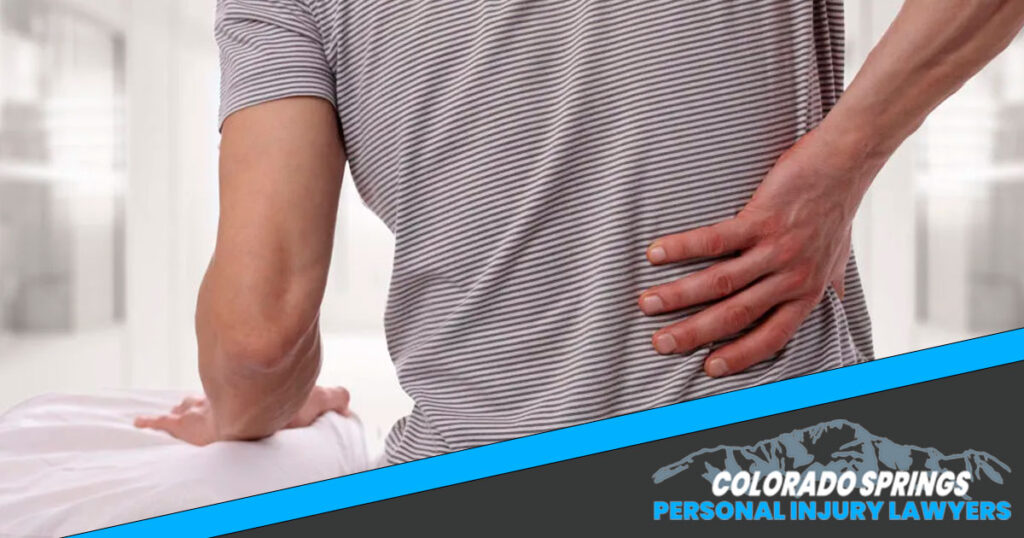Back injuries are a regular occurrence in everyday life, they can result from working around the house, gardening, playing sports, falling down and especially after a car accident, even a minor one. Injuries to the lower back or lower lumbar are the most common. Pain associated with this area is mainly caused by damage to the sciatic nerve which can be minor causing mild discomfort or pain that is absolutely debilitating preventing you from simple movement, day to day life, or from working.
The following article will provide you with understanding of the sciatic nerve, how it becomes damaged, how to identify and treat sciatica, and what kind of compensation and settlement you’re entitled to if someone else’s negligence causes you sciatic nerve damage after an accident in Colorado Springs.
What is the Sciatic Nerve?
The sciatic nerve is a long nerve, the largest in the human body, that runs the length of the legs to the feet from the lower back.The sciatic nerve is formed in the lower spine from five different spinal roots, they join together passing through the pelvis and deep through, yet not into, the buttock traveling down the back of the leg becoming two main branches, the tibial nerve and the peroneal nerve, which cover the back and the front of the leg and foot.
The sciatic nerve’s main purpose is to connect the central nervous system to your legs providing motor and sensory functions necessary for mobility and feeling.The motor function is responsible for muscle movement permitting you to stand, bend your knees, walk and run, whereas the sensory function brings feeling to the skin and legs. The sciatic nerve can also be damaged, impeding these functions causing a loss of mobility from pain that radiates through it from the lower back down the leg to the foot This irritation to the nerve is commonly referred to as “sciatica”.
What Causes Damage to the Sciatic Nerve?
Damage to the sciatic nerve or “sciatica” is caused by compression or pinching on the sciatic nerve or on one of the nerve roots usually from bulging disc tissue or inflammation near the nerve. Disc tissue that puts pressure on the nerve is usually caused by a herniated disc commonly referred to as ruptured or slipped disc, this occurs when the center protrudes out from between the vertebrae through a tear in the outer ring, also known as the annulus, putting pressure on the nerve roots located next to the disc.This can be the result of normal wear and tear as you age contributing to spinal stenosis, degenerative disc disease, or an injury resulting from an accident.
How Can a Car Accident Cause Sciatic Nerve Damage?
Trauma to the lower back from a car accident can damage the sciatic nerve causing sciatica pain. The pain can be caused by a new injury such as a herniated disc applying pressure to the nerve, or from an existing condition like asymptomatic degenerative disc disease aggravated by the trauma. Injuries like fractured or broken bones can create bone fragments and severe muscle bruising. The bruising can cause inflammation to the area next to the spine putting pressure on the nerve roots, and the fragments can irritate the sciatic nerve triggering a painful response in addition to the pain experienced by the fractured or broken bone.
A car accident can cause sciatica regardless of whether or not a person has a history of back issues. If a person has a predisposing condition, insurance providers will most likely try to combat claims for sciatic nerve damage making it more difficult to prove that the accident caused your pain and suffering.
What Are the Symptoms of Sciatic Nerve Damage From an Accident?
Symptoms of sciatic nerve damage can occur anywhere along the nerve path from the lower back, buttock/hip area, and down the back of the leg to the foot. Both legs can be affected but usually only present on one side. These are the most common symptoms for sciatica following an accident:
- A dull, aching or “burning” pain in your lower back.
- A shooting pain that starts in your lower back that goes down your buttock and one of your legs.
- Numbness or a tingling sensation that extends from your buttock down to your foot.
- Experiencing pain from the lower back down the leg from sitting and standing.
- Difficulty lifting and lowering your leg, foot or wiggling your toes.
- Muscle weakness which is a motor function issue and a more severe symptom.
In some cases, the pain is mild and merely irritating causing minimal disruption or it can be severe and completely debilitating. Either way, your everyday life can be hindered and the quality of your life drastically altered. If you experience any of these symptoms for more than two weeks be sure to see your doctor or primary care physician so they can properly diagnose and treat your injury.
Compensation for Pain and Suffering After Sciatic Nerve Damage
There are many types of compensation you can be entitled to after a car accident, and some have a non-economic cost that can take time to place a value on. Damage to your sciatic nerve can be a long and expensive recovery, physical pain can cause emotional distress and mental trauma that can make recovery more difficult, seriously lowering your quality of life.
Under Colorado law, any person who sustained a personal injury or bodily injury in a car accident is entitled to claim for pain and suffering damages. This type of compensation is more difficult to claim, you must prove that your back injury is the direct result of the accident and that the accident was caused by the negligence of the at-fault party. An experienced Colorado Springs car accident attorney will fight to recover these damages for you.
What is the Average Settlement for Sciatic Nerve Damage After an Accident in Colorado Springs?
Every accident is unique, there is no fixed amount for sciatic nerve damage. Settlements depend on how serious the injuries are and how much they interfere with the victims’ life. The more serious the injuries and complications to life, the higher the settlement will be, a Colorado Springs car accident or personal injury lawyer can evaluate and decide the value your claim deserves. Determining the value of your sciatic nerve injury claim will include the following considerations:
- The nature and extent of your injuries.
- The nature and extent of any impairment sustained from the injury.
- Therapy & medical treatment expenses including travel costs.
- Medical bills and expenses.
- If your injury caused permanent disability.
- Lost wages due to injury.
- Loss of earning potential if you are disabled.
- If the at-fault driver was adequately insured and their liability limits.
Choosing a knowledgeable attorney with extensive experience is critical for a higher settlement.
Insurance companies are less likely to give you a bad settlement or take your claim to trial if they’re dealing with a serious attorney with a solid reputation and a high rate of success. That’s why choosing an attorney that can get you a more favorable outcome is so important.
What Should I Tell My Doctor About the Accident?
You will need to provide details on how your injury was caused if you speak with your doctor about any symptoms mentioned above. You should share as much information with your doctor as you can. They may want to know when you started showing symptoms, where your pain is located, and if they happen more often during a particular activity or time of day. If you have been involved in a car accident, it is important to tell your doctor so they can diagnose correctly. These are examples of the information you should share with your doctor:
- When the accident occured.
- If you were the driver or a passenger.
- The direction the impact came from.
- The events immediately following the accident.
It is very important that you disclose all the details of your accident to your doctor during the initial appointment. Failure to mention your injury right away can bring to question the validity of your claim if it goes to trial and the doctor’s medical records are subpoenaed by the court.
Diagnosis and Tests for Sciatic Nerve Damage After an Accident
Diagnosis for sciatic nerve damage will most likely start with a physical exam from your doctor
checking muscle strength and reflexes. This will involve a combination of methods including:
Walking tests. Discomfort from sciatica will often affect the way you walk. Your doctor will ask you to walk normally, on your toes or on your heels to see if there are any noticeable changes.
Leg raise test. While you lie on your back with your legs straight the doctor will raise them one at a time asking if you notice any symptoms or pain. This movement can help locate the cause of the sciatica and decide the necessary treatment.
Flexibility and strength tests. Your doctor may ask you to do a series of movements or stretches, if you are able to do so, to determine if anything else is contributing to the cause of your sciatica symptoms.
Common testing to help diagnose sciatica and rule out similar conditions can include any of these:
X-ray: An X-ray of the spine produces a detailed image of the bones in your back using electromagnetic waves. This image can show if any bone overgrowth or fragments are pressing on, or irritating the nerve.
CT Scan: A CT (computed tomography) scan uses a series of X-rays arranged by a computer to produce a detailed image of the bones and soft tissues. This imaging test is painless and noninvasive used to detect diseases and injuries.
MRI: A MRI (magnetic resonance imaging) is used to evaluate, diagnose and monitor several medical conditions. It produces a clear image, generated by a computer, of the structures inside your body using a large magnet and radio waves.
Electromyography (EMG). An EMG test can establish the severity of damage to the nerve root by measuring electrical impulses produced by the nerves and the response of the muscles.
Treatments for Sciatic Nerve Damage After an Accident
Sciatica can usually be self-treated unless it is a severe case. Symptoms like numbness in the legs and feet, or weakness in the muscles require professional care, and sometimes surgery if symptoms persist and progress the condition further. Self treatment for mild to moderate cases involves increasing your mobility to alleviate symptoms.
If this is unfamiliar territory, a physiotherapist will assess your symptoms and help you get back your range of motion through a combination of treatments like cold and heat therapies to reduce swelling and increase movement, low impact exercise such as stretching, swimming, and gradually working up to core muscle strengthening activities and alternative therapies like yoga.
Sciatica is usually a temporary condition that passes with diligent self treatment. However, more moderate cases could require medical treatments involving epidural injections with corticosteroids, or a combination of prescription and non-prescription medications like painkillers, muscle relaxers and nonsteroidal anti-inflammatory drugs (NSAID’s).
Get the Colorado Springs Personal Injury Claim You Deserve
A damaged sciatic nerve, and other injuries sustained in a car accident can complicate the lives of the victims and their families for days, months and possibly years. It’s imperative to get the appropriate medical care for your injuries immediately, otherwise the quality of life for you and your family can be greatly diminished from needless pain and suffering.
Dealing with insurance companies is already a frustrating process. Delaying medical treatment will only complicate this by prolonging recovery, and creating additional mental and financial stress on top of pain from your injuries.
However, there’s a time limit to file your injury claim. A legal professional will help you to do that within the required time to make sure you are fully compensated for your losses. Finding a competent attorney you can trust to navigate the legal process for you will make all the difference especially if you experience any other complications after the accident, which your attorney can help you claim, like PTSD (post-traumatic stress disorder).
It may be in your best interest to seek care from a mental health professional if you suffer from any of the following symptoms:
- A prolonged or general sense of uneasiness
- Anxiety from or riding in cars
- Excessive fear or avoidance of medical tests and procedures
- Excessive anger, irritability and worry after the accident
- Trouble sleeping and nightmares
- Feeling of disconnect from friends and family
- Intrusive and uncontrollable thoughts about the accident
Contact a Colorado Springs Car Accident Attorney Today
Nerve damage is one of the most common reasons for back pain after a car accident.
It can cause temporary or permanent interruptions in your life, and prevent you from your enjoyment of daily activities or being able to work. Seek medical attention immediately following the accident to make sure there are no underlying injuries to your spine that are more serious than sciatica.
Our top rated and experienced Colorado Springs attorneys will make sure you get the personalized care you need to alleviate your stress and allow you to focus on recovery.To ensure you receive the maximum compensation from your settlement, our attorneys will provide you with the strong legal representation you deserve. Contact us today for a free consultation.

















